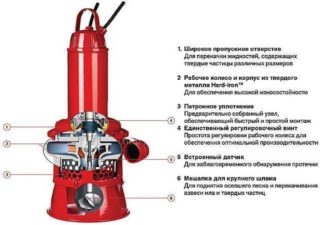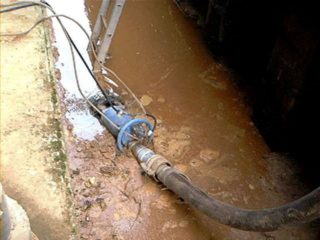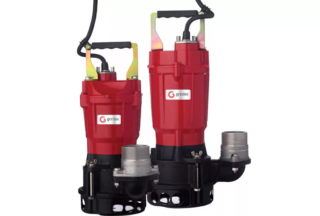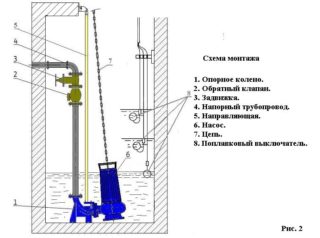The submersible pump is a very convenient and multifunctional unit that has found wide application in various fields: from water treatment and removal of sludge and drilling mud from wells to cleaning sewer and drinking wells, extracting sand and clay from quarries. Often they are also used for domestic purposes for pumping out septic tanks and sedimentation tanks, replacing drainage and fecal pumps that are weak and unable to suck in solid particles.
Submersible slurry pump device

A similar unit consists of the following parts:
- body made of stainless steel or gray cast iron;
- power plant - an electric motor (hydraulic motor), on the shaft of which the working bodies of the unit are located;
- the impeller (impeller) of the open type made of stainless steel;
- mixer (agitator) - a nozzle located on the shaft of the power plant, consisting of 2-4 blades, designed to destroy the bottom sediment and mix it with the liquid above; for more efficient performance of its function, the angle of the blades relative to the bottom plane is 60-80 degrees;
- outlet branch pipe for connection to the pump of the hose, which removes the suspension from the water and solid particles from the unit;
- electric cable or hydraulic flexible hoses to supply electricity / oil flow to the power unit.
A cylindrical casing with holes serves to protect the impeller from damage by stones during immersion. The hydraulically driven submersible slurry pump has two hose connections at the top of the power unit to supply oil to the power unit.
The units are used when it is necessary to pump out not only the contaminated liquid, but also the sediment at its bottom. Therefore, using them instead of fecal and drainage analogs that pump out only the liquid fraction of effluents is impractical and unprofitable - the cost of purchasing and operating a slurry pump is very high, part of its functionality will not be used when used for other purposes.
Principle of operation
The operation of a submersible slurry pump consists of the following operations:
- Placed strictly perpendicular to the bottom of the tank or reservoir, the pump rests against the solid sediment located there;
- When the drive is turned on - an electric motor or a hydraulic motor - the agitator rotating at high speed destroys the solid bottom layer;
- The suspension formed during the operation of the mixer is sucked in by the impeller blades;
- The rotating impeller blades feed the liquid contaminated with solid particles into the outlet, from where it comes out to the surface under high pressure through the hose attached to it or is pumped into another tank / reservoir.
Due to the presence of an agitator, the suspension is pumped out without the use of filter elements.
Application area

Due to its performance and reliability, the slurry pump is widely used for the following purposes:
- cleaning wells from the bottom layer of sand;
- pumping out a layer of sludge from sewerage basins and highways;
- pumping out viscous household wastewater;
- extraction of sand and clay from quarries;
- deepening of the bottom of silted beaches;
- removal of sand in the process of wastewater treatment in appropriate facilities;
- pumping out sludge at mining and processing plants;
- drainage of construction pits flooded by rain and groundwater;
- cleaning of old and silted reclamation canals.
The submersible slurry pump is also used for pumping clay and drilling mud from deep wells.
Main characteristics
The most important indicators characterizing the operation of the slurry pump are shown in the table.
| Characteristics | The values |
| Maximum productivity | From 20-40 to 300-430 m3 / hour |
| Power plant power | From 1.5-2 to 70-75 kW |
| Maximum head | 10 to 40-60 m |
| Operating temperature range, | -35 to +45 |
| Density | 1.3-1.5 to 2.5 g / cm3 |
| Temperature | +1 to +35 |
| Acidity | 5,5-13 |
| Maximum size / content of solids in pumped liquid | 5-10 to 30-40 mm / 20-25% |
Maximum productivity, power and head have a range with a fairly wide range of values. This is due to the wide variety of models and their purpose. Domestic pumps are characterized by lower power, performance and maximum head, while industrial models have higher values of these characteristics.
Protection systems
To prevent damage to the pump, the following protective devices are used:
- Leakage protection sensor - mounted in front of the O-ring separating the engine compartment from the impeller chamber. If water gets inside, it shuts down the power unit to avoid short circuit or oil leakage.
- Temperature sensor - installed in the stator (stationary winding of an electric motor) and serves to protect the unit from overheating during operation.
- Float - used in household units and serves to automatically shutdown the pump when the pumped liquid level falls below the protective casing on its impeller.
If at least one of the protective devices is turned off, the unit may fail at the most crucial moment.
Installation features
- The arrangement of the unit is perpendicular or at a slight angle to the plane of the bottom - with its working bottom surface, the pump must fully contact the bottom, otherwise the mixer will not be able to destroy and suspend the sediment located on it.
- Mobility - the pump must be suspended on a movable boom of the crane, the excavator bucket and, in the process of pumping out the liquid, must move along the bottom with their help. This is necessary in order for the unit to pump out the maximum amount of bottom sediment, and not burrow into it while stationary.
- Full coverage of the pump housing with working fluid for efficient cooling.
If at least one of the specified installation features is not observed, the pump will poorly pump out the suspension, burrow into the bottom, and overheat greatly during operation.
Advantages and disadvantages
The main advantages of slurry pumps are:
- high performance;
- reliability and durability of working units;
- the ability to work in difficult conditions;
- pumping water heavily contaminated with solid particles.
Among the disadvantages are:
- high price;
- low maintainability on their own;
- high cost of spare parts.
Also, the disadvantages of such units include their large weight compared to drainage pumps.
Main manufacturers

Among the wide variety of companies that produce slurry pumps, the most popular are:
- DAMBAT;
- Hycon;
- Dragflow;
- Tsurumi Pump;
- Dynaset;
- Grindex.
These manufacturers have a wide range of models for domestic and industrial use.









